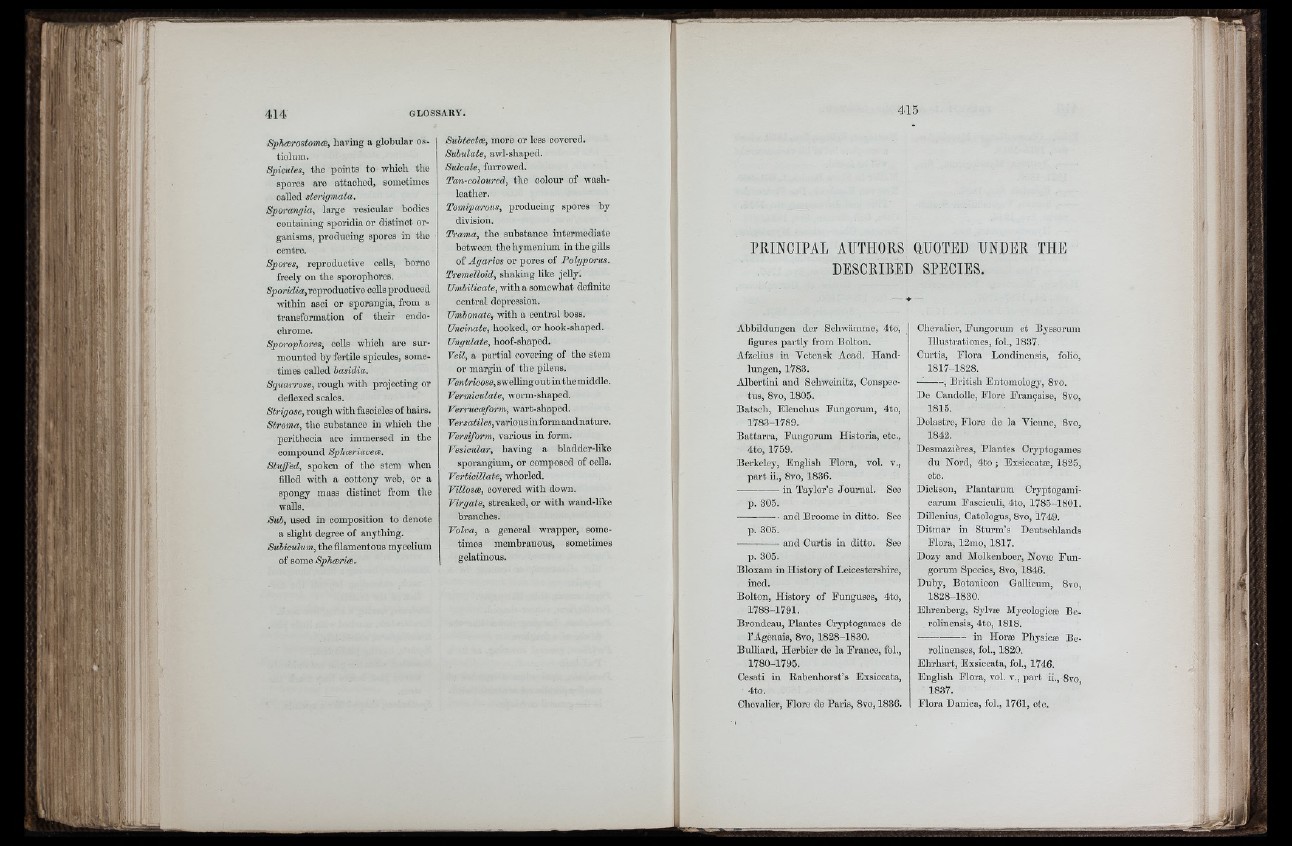
Sphoerostomoe, having a globular o stiolum.
Spicules, tlie points to wliicb the
spores are attached, sometimes
called sterigmata.
Sporangia, largo vesicular bodies
containing sporidia or distinct organisms,
producing spores in the
centre.
Spores, I'eproductivc cells, borne
freely on the sporophores.
reproductive cells produced
within asci or sporangia, from a
transformation o f their endo-
ehrome.
Sporophores, cells which are surmounted
by fertile spicules, sometimes
called hasidia.
Sq^iiarrose, rough witli projecting or
deflexed scales.
Strigose, rough with fascicles o f hairs.
Stroma, the substance in which the
perithecia arc immersed in the
compound Sphæriaceoe.
Stuffed, spoken of the stem when
filled with a cottony web, or a
spongy mass distinct from the
walls.
Suh, used in composition to denote
a slight degree of anything.
Suhiculum, the filamentous mycelium
o f some Sphæriæ.
Suhtectæ, more or less covered.
Subulate, awl-shaped.
Sulcate, farrowed.
Tan-coloured, the colour o f wash-
leather.
Tomiparous, producing spores by
division.
Trama, the substance intermediate
between the hymenium in the gills
of Agarics or pores o f Polyporus.
Tremelloid, shaking like jelly.
Umbilicate, with a somewhat definite
central depression.
Umbonate, with a central boss.
Uncinate, hooked, or hook-shaped.
Ungulate, hoof-shaped.
Yeil, a partial covering o f the stem
or margin o f the pileus.
Ventricose, swelling out in the middle.
Vermieulate, worm-shaped.
Verrucæform, wart-shaped.
f, various informandnature.
various in form.
Vesicular, having a bladder-hko
sporangium, or composed of cells.
Verticillate, whorled.
Villosæ, covered with down.
Virgate, streaked, or with wand-like
branches.
Volva, a general wrapper, sometimes
membranous, sometimes
gelatinous.
PRINCIPAL AUTHORS QUOTED UNDER THE
DESCRIBED SPECIES.
Abbildungen der Schwämme, 4to,
figures partly from Bolton.
Afzolius in Vetensk Acad. Handlungen,
1783.
Albertini and Schweinitz, Conspectus,
8vo, 1805.
Batsch, Elenohus Fungorum, 4to,
1783-1789.
Battarra, Fungorum Historia, etc.,
4to, 1759.
Berkeley, English Flora, vol. v.,
part ii., 8vo, 1836.
--------------in Taylor’s Journal. See
p. 305.
--------------and Broome in ditto. See
p. 305.
--------------and Curtis in ditto. See
p. 305.
Bloxam in History o f Leicestershire,
ined.
Bolton, History o f Funguses, 4to,
1788-1791.
Brondeau, Plantes Cryptogames de
I’Agenais, 8vo, 1828-1830.
Bulliard, Herbier de la France, fo l,
1780-1795.
Cesati in Babenhorst’s Exsiccata,
4to.
Chevalier, Flore de Paris, 8vo, 1836.
Chevalier, Fungorum et Byssorum
Illustrationcs, fo l, 1837.
Curtis, Flora Londinensis, folio,
1817-1828.
, Britisli Entomology, 8vo.
B e Candolle, Flore Française, 8vo,
1815.
Delastre, Flore de la Yienne, 8vo,
1842.
Desmazieres, Plantes Cryptogames
du Nord, 4to ; Exsiccatæ, 1825,
etc.
Dickson, Plantarum Cryptogarai-
carum Fasciculi, 4to, 1785-1801.
Dillcnius, Catologus, 8vo, 1749.
Ditraar in Sturm’s Deutschlands
Flora, 12mo, 1817.
Dozy and Molkenboer, Novoe Fungorum
Species, 8vo, 1846.
Duby, Botanicen Gallicum, 8vo,
1828-1830.
Ehrenberg, Sylvæ Mycologicæ Be-
rolinensis, 4to, 1818.
------------------in Horse Physicoe Berolinenses,
fo l, 1820.
Ehrhart, Exsiccata, fo l, 1746.
English Flora, vol. v., part ii., 8vo
1837.
Flora Danica, fo l, 1761, etc.
ii Í
d’-
f j